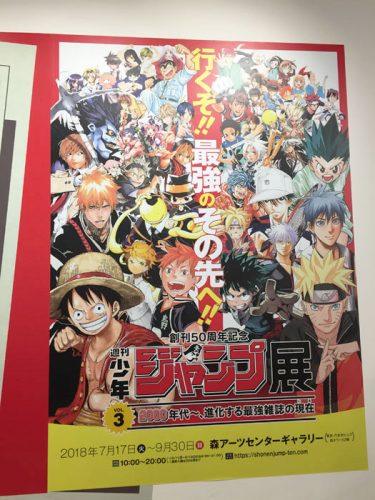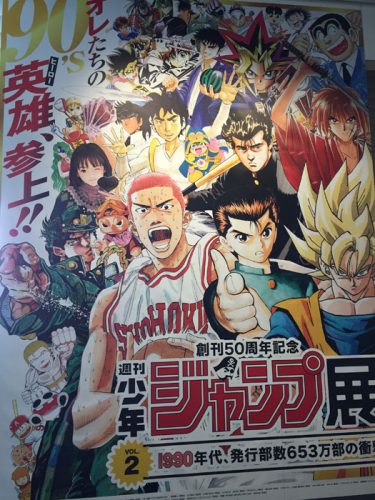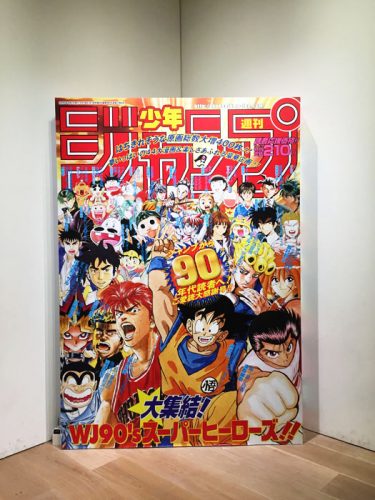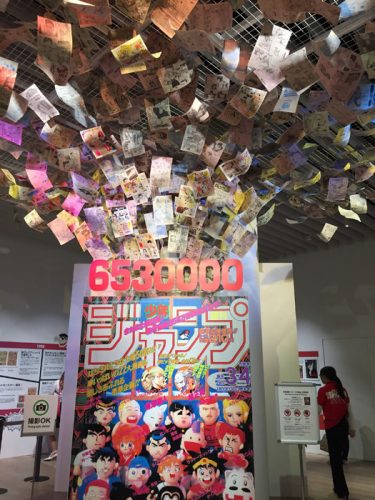
For those of us who have grown up with shounen manga titles, or those of us who love to read classic shounen titles, this is, of course, the one event we can’t just let pass by! In celebration of their 50th anniversary, Weekly Shounen Jump is holding a massive exhibition documenting their entire history, displaying all of their published titles in a rather nostalgic walk right at the Mori Arts Center in Roppongi, Tokyo. As it is 50 years worth of history, they had divided the exhibition into three volumes: the 70-80s, the 90s, and the 2000s. Presently, the second volume of the exhibition is being held, and it is, as expected, an amazing spread!
It is a widely known fact that Weekly Shounen Jump reached their historical peak of magazine circulation. This means there are a lot of classic, much-beloved titles included in the 1990s part of their exhibition, and both Honey-chan and Bee-kun are really looking forward to walking down that road of nostalgia! Along with some friends and meeting up at the Roppongi Station, it was a short walk from there to Mori Arts Center where the exhibition was being held. With the many posters of the exhibition on the way, it’s impossible to miss! While you can also buy tickets in advance at convenience stores, it seemed that Bee-kun completely forgot to buy the tickets. Not to worry, though, because we all could also buy tickets on the spot, before lining up towards the elevator that brought us up to the exhibition floor on the 52nd floor!
Weekly Shounen Jump: A History
Known as a long-time best-seller as well as one of the longest-running manga magazine, Weekly Shounen Jump is a shounen manga anthology magazine that, theoretically, targets young male readers. Published by Shueisha as one of its many Jump line of magazines, Weekly Shounen Jump initially began their run as a biweekly manga magazine, before their circulation picked up and they began running as a weekly manga magazine starting the year 1969. It features more than half of the current most popular series as well as some that had gone on to be classic legends, including Dragon Ball, Rurouni Kenshin, Naruto, Gintama, Boku no Hero Academia, and of course, One Piece. The current Weekly Shounen Jump has hosted no less than twenty-three titles—half of them with their own anime adaptations adding to their popularity.
Considering those titles, it is probably impossible for anime and manga fans to have never heard of Weekly Shounen Jump. At the very least, one of every manga fans’ favorite titles must have been published in Weekly Shounen Jump, at some point or another. Since 1999, Weekly Shounen Jump has also been holding a large convention called Jump Festa, which had gone to be one of the most awaited conventions in Japan. Weekly Shounen Jump is also the one who holds the annual competitions for newcomer mangaka, which gives winners the prestigious Tezuka Awards and Akatsuka Awards.
Weekly Shounen Jump is pretty much the best-selling manga magazine in Japan. Despite the fact that its circulation had been declining since its peak in the mid-1990s, it still reached 1.9 million copies in early 2017. It was in 1995 that Weekly Shounen Jump reached its historical peak of circulation, reaching a breathtaking number of 6.53 million, with hit titles you will get to see in the second volume of the exhibition!
| LENGTH OF EVENT | March 19 – June 17 2018 (Volume 3 of the Exhibition will be held on July 17 to September 30 2018). |
|---|---|
| PLACE / LOCATION | Mori Arts Center Gallery, Roppongi Hills Mori Tower 52F. |

After waiting in line for about 15 minutes, all of us were ushered in to a table right by the window, which gave us a gorgeous view of the city of Tokyo, since we were on the 52nd floor! While not all of the 1990s titles get to be turned into food and beverages at this café, all of them looked super tasty and interesting. Fans of Dragon Ball series would be happy to see the “Krillin no Koto Curry”, which is a pun on Goku’s line of anger in his battle with Frieza. You can also eat a “Frieza-sama’s 530,000 Power Level Parfait”! Fans of the Nube series should definitely try the adorable “Yukime Daifuku Dessert”, while fans of Yu-Gi-Oh would enjoy trying to solve the Millenium Puzzle by ordering the “Millenium Puzzle Dessert”. If you’re a Slam Dunk fan, don’t worry, there’s “Anzai-sensei’s Taputa Purin” for you to try, so you can pretend to be Hanamichi and yell at the dessert just like Hanamichi did! There are also other menus available, including a Dragon Quest-themed burger, “Kurama’s Rose Whip Dessert Plate” from the Yu Yu Hakusho series, and even Houshin Engi-themed cocktail.
Once we have satisfied our stomachs, Honey-chan and Bee-kun excitedly dragged everyone towards the exhibition area. The attendant warned us to keep our ticket until the end so we could exchange it for a free sticker at the exhibition exit! As we walked in, we were ushered towards a multimedia room where a short movie of Weekly Shounen Jump’s historic titles played, and then another one where we got to watch a short PV of Dragon Ball’s Goku and Frieza’s decisive battle. With that, we all proceeded to the opening section of the exhibition where one of the most legendary titles of Weekly Shounen Jump is displayed: Dragon Ball! A number of its very iconic moments were displayed, including manga panels of Goku’s anger in his battle with Frieza, as well as Goten and Trunks’ fusion. There was also a glass case with a selection of Dragon Ball merch that some of us might have grown up with!

The more popular series, however, got to have a much more massive display. Just like Dragon Ball, which had an entire room dedicated to it, Jojo’s Bizarre Adventure’s series got entire walls decorated with life-sized panels of its characters as well as framed color illustrations. The noises both Honey-chan and Bee-kun made at the sight of it was hilarious! As we progressed, we also got to see the impressive displays for Yu Yu Hakusho series, which made some of us extremely nostalgic seeing the iconic manga panels of Kurama turning into his fox spirit self, Youko, or the ‘death’ of Kuwabara in the Dark Tournament. There was even a special PV on the screen that showed each of the main characters’ iconic moments in manga panels!
Fans of Slam Dunk series would be beside themselves once they reach the Slam Dunk area—gigantic panels of the characters on entire walls, with the iconic opening song “Kimi ga Suki da to Sakebitai” playing in the background, and framed manga panels of each characters’ special moments right under them. It’s 2018, and we still get to see Rukawa’s good looks on an entire wall! Don’t miss the screen on the corner playing a short PV of the final match in the manga, either, because why would you miss a glimpse of Hanamichi and Rukawa’s high-five? It’s really what Slam Dunk deserves—after all, it was the series that brought the NBA fever sweeping all across Japan!
Another series that got an entire room of memorabilia was, of course, Rurouni Kenshin, which was a classic title that got huge not only in Japan, but all over the world. There were wall tapestries of most of the main characters, and the if you paid close attention to the framed manga panels of the wall, you’d get to see the most iconic moments in the manga, from the beginning where Kenshin met Kaoru, his parting with Tomoe, to his battle with Seta Soujirou and Shishio Makoto, to the very end where he finally settled everything with Tomoe’s brother, Enishi, and the very last panel in the manga with Kenshin, Kaoru, and their child Kenji.

Those who loved Yu-Gi-Oh would also love the entire room dedicated to display Yu-Gi-Oh series! Along with the framed manga panels and illustrations, there were also a display of each character’s favorite cards in their decks. It’s so nostalgic to see both Kuriboh and Black Magician under a wall-sized illustration of Mutou Yuugi! You can also peer into a hidden screen shaped like a millennium puzzle to see silhouettes of Dark Magician and his apprentice, Dark Magician Girl. There were panels representing each important arcs—from Yuugi’s battle with Yami Bakura to his iconic, life-on-the-line battle with Jounouchi, and of course, the farewell scene with Yami Yuugi.
The displays and memorabilia for each series were very impressive, but that’s not the only thing this exhibition offered. Halfway through the exhibition, you’d stumble into an impressive hall documenting the publishing process, collaborations, and projects that Weekly Shounen Jump achieved in the 1990s period. There were also screens playing interviews with three of the prominent mangaka at the time, including Slam Dunk’s Inoue Takehiko, and the famous man who brought us both Yu Yu Hakusho and Hunter x Hunter, Togashi Yoshihiro. In the very center of the room was an amazing setup of a Weekly Shounen Jump tree, with pages and pages of the magazine hanging off the ceiling. It really gave us a touching feeling of having been a part of Weekly Shounen Jump as readers!
Towards the end of the exhibition, there was a special corner displaying titles published in the end of 1990s that would see us over to the 2000s period. These are the titles that were early works of mangaka who later shot to popularity after their hit titles in 2000s period: Konomi Takeshi, for example, who would be widely known by his Prince of Tennis series, wrote both COOL and RENTAL BODYGUARD. Kishimoto Masashi, known for Naruto, had his earlier work Karakuri up on display in this section as well. And of course, our favorite Oda Eiichirou who has brought us One Piece, with the One Piece Romance Dawn shot, and Kubo Tite, who brought us Bleach, with his Zombiepowder!

Final Thoughts
Finishing the exhibition was a complicated feeling of wanting to see more and looking forward to the next volume of the Weekly Shounen Jump exhibition, which would start on July and go on until September this year. It was a nostalgic walk through the 1990s, but also an exciting road of thinking about the series that would come after these hit titles, as well as remembering all the titles that are being published in Weekly Shounen Jump right now. What a ride this magazine has been on! It’s such a marvel how many hit titles it churned, and how many of those titles became the defining series of otaku culture in its period.
If you’ll be visiting Japan this year, be sure to drop by the Weekly Shounen Jump exhibition and revisit the journey of your life as an anime and manga fan! Volume 2 of Weekly Shounen Jump exhibition will be held until June 17 2018, and the exhibition for Volume 3 will begin on July 17 2018. Volume 3 will definitely have a lot more hit titles that are currently still very popular, so be prepared for long lines and a literal war over entrance tickets!


No comments:
Post a Comment